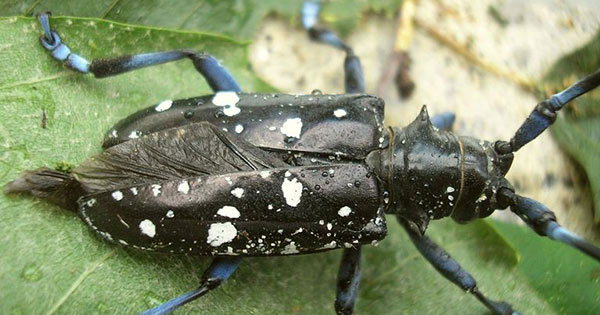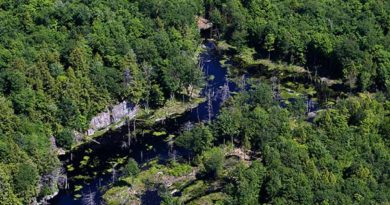How collaboration kept an invasive beetle at bay
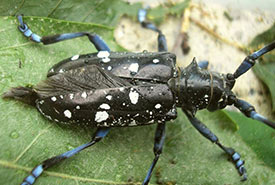
Asian longhorned beetle with wing exposed under elytron (wing casing) (Photo by Pudding4brains, Wikimedia Commons)
What is black with white spots and shiny all over? It’s the invasive Asian longhorned beetle (ALB)! This beetle is well known for its striking appearance, piercing eyes and antennae that extend beyond the rear of its body. It has no natural predators or parasites in the areas of North America where it’s been accidentally introduced. The ALB has a voracious appetite for hardwood trees, like maple and poplar. Its larvae feed in the cambium and xylem layers underneath the tree’s bark, causing trees to decline and eventually die.
Since 1980, ALB has been intercepted dozens of times at Canadian ports of entry. Efforts from community scientists and the Canadian Food Inspection Agency (CFIA) kept Canada ahead of the ALB until 2003, when a population was discovered by a member of the public in an industrial area north of Toronto. Immediately, a 150-square-kilometre quarantine zone was established around the detection site to restrict the movement of wood materials. By the following spring, 531 infected and high-risk were removed and destroyed, in addition to 12,500 high-risk trees in the regulated area.
After the removal of the trees, the Canadian Forest Service and multiple survey crews continued to monitor trees within the regulated area, looking for any signs of ALB. From 2004 to 2007, an additional 40 infested trees were detected and removed each year. Fewer than 15 infested trees were found in 2007, and no infested trees were found in the remainder of the surveys between 2007 and 2013. With no signs of ALB in the area, the insect was officially declared eradicated in April 2013 by the CFIA.
Unfortunately, celebrations were short-lived. In December 2013, an adult beetle was collected and positively identified as ALB in an industrial area of Mississauga, outside of the original quarantined area. Again, early detection of the new infestation allowed for rapid response. The area was extensively surveyed, and technicians found two Norway maples and three Manitoba maples that showed signs of infestation. One of the Manitoba maples was heavily infested with over 900 insect exit holes!
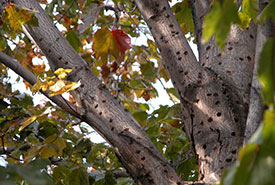
Asian longhorned beetle exit holes on a Manitoba maple (Photo by Aspen Zeppa, OMNRF, via forestinvasives.ca)
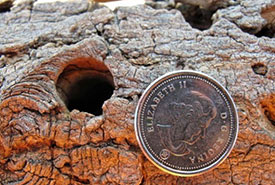
Size reference for an Asian longhorned beetle exit hole (Photo by Aspen Zeppa, OMNRF, via forestinvasives.ca)
Each tree that was removed was carefully inspected for signs of ALB damage and then destroyed. Throughout this process, 25 more infested trees and 17 suspect trees were discovered. Attention to detail during the rigorous surveillance work went a long way toward achieving a successful eradication program. For example, technicians were suspended in the bucketed lift of boom trucks to observe activity in the tree canopy while others zoomed in from the ground using binoculars. Canadian Forest Service researchers even tested the sharp eyes of the technicians by drilling counterfeit exit holes to ensure a high degree of certainty in their inspections.
ALB adults, if disturbed, fly out of the tree canopy, land and wait in a safer place, and then fly right back up to the same host tree. ALB were seen to feed on this single tree for several successive generations before searching for a new host, as indicated by negative survey results on the properties surrounding this site. Since this was the case, and since many detections of ALB were made near or on vehicles, it was deduced that cars and trucks were a key mode of transportation for ALB between the Toronto and Mississauga sites.
In June of 2020, the Asian longhorned beetle was officially declared eradicated from the city of Toronto and Mississauga by the CFIA after a long management and eradication effort for which preparation began prior to the first detection of the insect in Ontario in 2003.
The Canadian Forest Service and other contributors to research and surveillance were able to produce data and results that helped their efforts and the efforts of partners across the border. While the eradication and control strategy in the U.S. was centred on insecticide application, the strategic surveillance and the prompt tree cutting and chipping method used in Ontario proved effective and was later replicated in Chicago, and counties in Massachusetts.
The Canadian partners involved — including the Canadian Forest Service, Canadian Food Inspection Agency, Ontario Ministry of Natural Resources and Forestry, Ontario Ministry of Agriculture Food and Rural Affairs, university professors, local conservation authorities, the Cities of Toronto and Mississauga, alongside the Toronto area community — were able to see the project to its successful end. To date, there have been no new detections in the area, so celebration was called for in June 2020; however, the partners aren’t letting their guard down.
Recent ALB activity from around North America:
- ALB intercepted and quickly dealt with by the CFIA in Edmonton, Alberta, in May of 2019.
- Another infested tree was found and removed within the town of Auburn, Massachusetts, already in a 284-square-kilometre quarantine zone in Worcester County.
- ALB detected and confirmed in Hollywood, South Carolina, in late May 2020. USDA APHIS is now working with the Clemson Department of Plant Industry and Clemson Extension to understand the scope of the infestation, as well as how the beetle is spreading in this coastal South Carolina habitat.
While success stories in invasive species are more common than we think, plants, animals and pathogens are more frequently being transported around the world; travel and trade are two of the most common invasive species pathways. Any species can travel and thrive unchecked by the natural predators and pathogens that would be present in its home range. We all have a part to play in safeguarding the health of our forests, now and into the future.
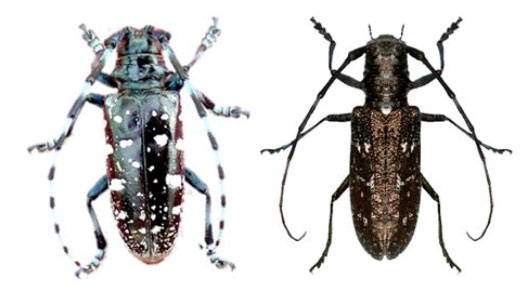
Invasive Asian longhorned beetle (left) and native white-spotted sawyer beetle (right). (Photo by Michael Bohne, USDA Forest Service, Bugwood.org)
Want to help keep invasive forest pests like ALB from being introduced to or spreading in Canada? Follow these tips to help keep our trees invasive species-free:
- Learn to identify ALB, and to differentiate it from its native lookalike, the white-spotted sawyer beetle (above). If you think you have found an ALB, report the siting on iNaturalist or call the CFIA.
- Only use firewood sourced from local forests, and don’t transport it over distances of 80 kilometres.
- Check wood packaging materials of products that are of international origin.
For more information on the Asian longhorned beetle and other species that affect forest health, visit the Invasive Species Centre website.

